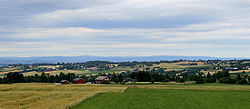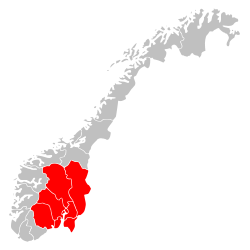- Eastern Norway
-
Eastern Norway
Østlandet— Region (landsdel) — Nickname(s): East-Norway Country Norway Capital Oslo Counties (fylker) Østfold
Akershus
Oslo
Hedmark
Oppland
Buskerud
Vestfold
TelemarkArea – Total 94,577 km2 (36,516.4 sq mi) Population (01.10.2010) – Total 2.454.712 – Density 25.96/km2 (67.2/sq mi) Demonym Eastlendic people Historical populations Year Pop. ±% 1769 329,041 — 1951 1,584,045 +381.4% 1960 1,733,346 +9.4% 1970 1,895,148 +9.3% 1980 1,982,131 +4.6% 1990 2,064,971 +4.2% 2000 2,207,164 +6.9% 2010 2,430,512 +10.1% 2020 2,708,720 +11.4% 2030 2,970,713 +9.7% Source: Statistics Norway [1][2][3][4][5][6][7][8][9][10][11][12][13][14][15][16]. Eastern Norway (Norwegian: Østlandet (Bokmål) or Austlandet (Nynorsk)) is the geographical region of the south-eastern part of Norway. It consists of the counties Telemark, Vestfold, Østfold, Akershus, Oslo (city), Buskerud, Oppland and Hedmark.
In Norwegian, the region is called Østlandet (lit. "east country") in distinction of Vestlandet ("west country"). It is translated into "Eastern Norway" in English, although technically "South-eastern Norway" would be more geographically (not linguistically) correct, since geographically Northern Norway is farther east.
Geography
The region has 2 454 712 inhabitants (01. oct 2010), spread on 94 577,87km2.
The region is delimited by mountains in the north and west, by the Swedish border to the east and by Viken and Skagerrak to the south. The border towards Sørlandet is less pronounced.
The mountains reach a height of 2469 metres in the Jotunheimen mountain range, the highest point in the Nordic countries (excluding Greenland). Other prominent mountain ranges include part of the Dovrefjell in the far north of the region, the Rondane north east of Lillehammer and others. The high plateau of Hardangervidda extends into Western Norway.
Valleys cut deep into the mountains, from east to west the main valleys are Østerdal, Gudbrandsdal, Valdres, Hallingdal, Numedal and the valleys of Telemark. Østerdalen is surrounded by mostly flat areas of conifer forests, but the others are all deeply cut into the mountains.
The area around the Oslo fjord and towards the north east are comparatively flat, and there are patches of intensely cultivated lands, notably Hedmark, Toten, Hadeland, Ringerike and others. The population density in the flatlands is the highest in the nation, and some 40% of the nation's population lives within 200 km of Oslo. Numerous islands shelter the coasts, creating a paradise for swimmers and boaters in the summer.
People, culture and folklore
The Norwegian dialects spoken in the south-east share a common intonation, but there is some variation in grammar, vocabulary and pronunciation. The dialects of the interior mountainous areas (Hedmark, Oppland, and interior parts of Buskerud and Telemark) are all distinct and some are even hard for other Norwegians to understand. The dialects of the coastal areas (Telemark, Vestfold, Akershus, Buskerud, Oslo and Østfold) are more similar to the written language (bokmål).
The eastern forests of Finnskogen were the home of an ethnic minority, immigrants from Finland that came in the 17th c. Their language and culture was preserved into the 20th century, but now only folk tunes and food specialities remain. The southernmost group of Norway's Sami population is to be found in the north-eastern corner, in Engerdal.
The culture of mountain valleys is preserved to a greater degree than the more urbanized metropolitan areas. The area is distinguished with traditional architecture (stavkirke, lafting), folk music and food. Some are concerned for the loss of local culture in the face of modernization. Especially in the ski resorts in the mountain is transformed by the people from the cities, with increased building of shops, hotels and vacation houses.
The coastal region is densely populated both by Norwegian and European standards. This region was the early industrialized. Traditionally the biggest export was timber and shipping, now employment in the industrial sector is in decline and most people are working in service oriented companies. The coastal area is varied, from the metropolitan Oslo to the more quiet and idyllic old maritime city of Drøbak, and the oldest city in Norway, Tønsberg
Oslo, the capital of Norway, has attracted people from all over Norway. Most of the immigrants settle here as well. There are numerous mosques, Hindu shrines, Sikh temples, and Buddhist temples, giving Oslo a cosmopolitan feel.
References
Regions of Norway - Eastern Norway (Østlandet / Austlandet)
- Northern Norway (Nord-Norge)
- Southern Norway (Sørlandet)
- Trøndelag
- Western Norway (Vestlandet)
 Categories:
Categories:
Wikimedia Foundation. 2010.


